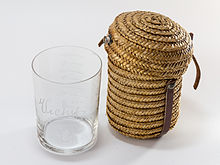Well cure

During a well cure , also called drinking cure , water from healing springs is regularly drunk over a longer period of time for therapeutic purposes. This form of treatment has been prescribed to the 20th century in numerous diseases and was in German spas practiced most frequently Kurform . Even today it is still part of a cure, but has clearly lost its importance. In the 19th century, the milk cure was also very popular as a special form of drinking cure.
history
Well cures were introduced in the 16th century. Caspar Brusch wrote about the Bohemian spa town of Franzensbad in 1542: “In front of the Bruck gate is (...) a noble and almost famous fountain, has acidic water, which is why the sourling is also called; this water is very healthy and fun to drink, and in summer (...) it is carried into town in heaps in jugs. ”It was the Egerbrunnen , later called Franzensquelle .
During this time u. a. Wiesbaden , Bad Ems , Bad Schwalbach and Bad Kissingen are known as health resorts with medicinal springs, in Austria Baden near Vienna . The procedure for the cure at that time was based on the motto "A lot helps a lot": The bathers drank incessantly from the mineral fountain from morning to night, often up to 20 liters per day. In order to mask the rather unpleasant taste of the water, it was sometimes mixed with milk or wine. Certain side effects of some sources were considered quite desirable; so there was known Furzbrunnen (z. B. in Bad Schwalbach) or Kotzquellen (as in Leukerbad ). In addition, most medicinal waters have a strong laxative effect in large quantities, so that most of the spa guests certainly suffered from diarrhea . Obviously, this did not affect the popularity of the drinking cures.
The Hamburg judiciary Johann Peter Willebrand describes the curriculum in 1781 in his book Nachrichten von einer Carlsbader Brunnen Reise : “At last I was condemned to continue every morning for at least three weeks (...) at 5 or 6 o'clock eleven cups of what I thought about hot sparkling water, it would be possible to drink at the source of the sparkling water in such a way that I used a mug every ten minutes while constantly pacing back and forth. ”Eleven mugs were probably a maximum of two liters, which was very moderate for the time. Other spa guests in Karlovy Vary were also prescribed double the amount. And so it was inevitable that the gentlemen “often have to break off with an excusez in the middle of scratching feet in order to rush into the cabinet of necessity”. The cabinet of necessity was the toilet.
In Meyers Konversationslexikon from 1889 it says: "The water is usually drunk on an empty stomach in doses of 60 to 90 g and in a total quantity of 400 to 1600 g depending on the effect and the case of illness." So the dose was further reduced by the doctors. It goes on to say: “Under no circumstances can the duration of the cure be shortened by increasing the number of cups. (...) While drinking, moderate exercise is necessary without any overheating or fatigue. The last cup must be drunk at least 1-2 hours before breakfast. "
So that the spa guests could follow their drinking cure even in bad weather, so-called fountain halls and changing halls were soon built in the health resorts .
See also
literature
- Vladimír Křížek: Cultural history of the spa. Kohlhammer, Stuttgart 1990, ISBN 3-17-010589-2 .
- Horst Prignitz: water treatment and bathing pleasure. A bathing trip into the past. Koehler and Amelang, Leipzig 1986, ISBN 3-7338-0011-7 .

